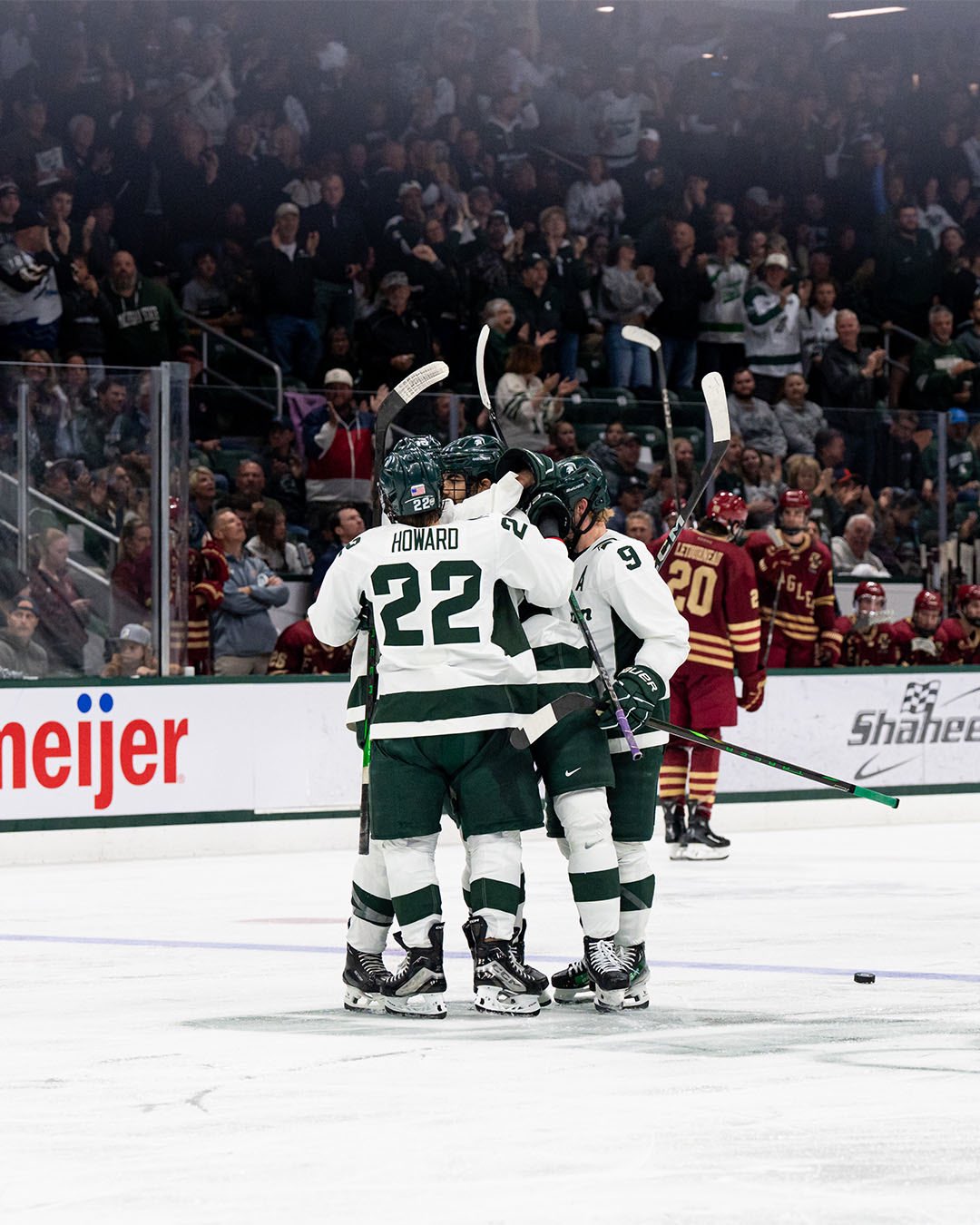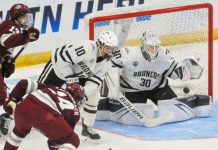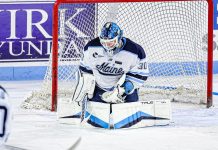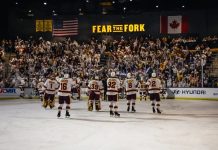
Paula: Dan, it’s great to be back with you to talk college hockey in this season’s second installment of TMQ. Even though the season is young, there’s a good deal to dig into, both on and off the ice.
Last week, Jim Connelly and Ed Trefzger began a discussion about the implications of the NCAA granting eligibility to Canadian major junior players and I’d like to hear your thoughts on that later in the column, but for our first conversation of the season, I’m throwing out the word that so many fans despise and so many coaches use: parity.
And, honestly, the conversation about the NCAA’s proposal and the P-word intersect, especially when terms like “blue bloods” and “elites” come into play.
What transpired on the ice this past weekend brings me to it, though. One week after Stonehill upset Merrimack, Lindenwood – a team with six wins last season – split with Wisconsin, a 4-2 win Friday and a 3-2 overtime loss Saturday. The Lions didn’t trail in that series and only lost when Daniel Laatsch scored the game-winner with 18 seconds to spare in OT.
On the other end of the PairWise spectrum (so to speak), Boston College and Michigan State split a pair of games in Munn Ice Arena, with each team exploding for three second-period goals in its win: 3-0 for BC on Friday, 4-3 for the Spartans Saturday.
There were 16 games decided by a single goal and four OT ties, several come-from-behind wins, and some other notable results, like Omaha beating Minnesota 2-1 in overtime for the Ice Breaker title and Merrimack shutting out Minnesota State 1-0.
Is this an early harbinger of a season that will produce many surprises and upsets? Is this a sign of some teams – from up and down conference standings – starting where they left off at the end of 2024-25? Or is it too early to make much of anything here?
Dan: Based on the child-based crash emanating from the other side of the wall, talking about college hockey is exactly where I’d like to be right about now, so welcome back to another wonderful season where you and I get to play hooky from our responsibilities while we talk about the best and fastest game on Earth.
Paula: As someone living at a latitude nearly identical to Niagara Falls, Ont., and about 78 miles northwest of Windsor, Ont., I think it’s cute that you see Canada a strictly northern proposition, Dan.
I’m also an easy drive between two Ontario Hockey League teams that play right here in Michigan, the Saginaw Spirit and the Flint Firebirds.
All chiding aside, that geographic perspective that echoes a kind of Canadian invasion is a fascinating metaphor for this moment in college hockey. There is a two-camps mentality at play here that I fall victim too as well, but I’m not sure that an either-or model holds up to scrutiny.
Players in the major juniors are still college-aged kids, and I don’t think that giving them NCAA eligibility differs much from the way current NCAA players are allowed to be drafted and remain NCAA eligible.
Yeah, I know that players in the major juniors are playing professional hockey – but they’re not getting rich doing so, and in many cases, they’re not being developed well. The Canadian major junior leagues have histories of lying to players about pay, bonuses, and reimbursement for college tuition should they forego the NCAA route for the major juniors.
I really dislike seeing people – especially young people – exploited for the profit of others.
That is why I’m fully behind the NIL. I understand the relationship between big collegiate sports programs like football and how smaller programs (fencing, wrestling) are funded, but exploiting student-athletes to do so is wrong.
There are too many people profiting from the play of young athletes – in the NCAA, in major junior hockey – who are not the athletes themselves. That’s what it really comes down to for me.
One potential area of worry for me is the continued manipulation of players who come to the NCAA from major junior hockey. These are players who will have had greater exposure to all of the people who want to exploit their careers. Not only will those individual student-athletes need protection from such exploitation, but so will the programs they enter.
The lines between amateur and professional are already blurred in sports in so many ways, and as an old lady, I’m surprised by how little that bothers me. What does trouble me is money. From betting culture to access, there are too many ways in which sports culture can be corrupted to profit individuals at the expense of collegiate players.
There’s more to this in my mind, too, but I’m still working to articulate it accurately. I’m not sure this I followed the way you were steering things, Dan, but that’s where I went.
Dan: That’s an interesting take. I’m not really sure where I was heading with this, but I really like the idea of hashing out the CHL vote in the framework of the kids’ ages. Also, for the record, anything west of the 128-Mass Pike interchange for a Boston-area guy is New York. The fact that I moved outside that exit and live in the same county as where I grew up – with its multiple orange line MBTA stops – made me recalibrate my whole geographic orientation in Massachusetts.
Shoutout the 24 people reading this who understood that sentence… also shoutout the Big Ten and NCHC fans who just imploded at me waxing poetic over New England in the fall.
Paula: I hear you, Dan. It’s a weird new landscape that we’re navigating. So much has changed in recent years – the COVID eligibility, the portal, NIL, now the prospect of major junior players – and it’s quite dizzying.
One more thing before I leave this topic altogether. I’ve been hearing the term “blue bloods” bandied about, with Ohio State coach Steve Rohlik talking about it a little on the record last week and whispers about the term in other places.
I’ve never liked the idea of the “elites” in college hockey, the implication that some programs are better because of something inherent to their identity rather than to certain very real circumstances, and the term “blue bloods” kind of shakes me. From covering the old CCHA, I remember the disparity among big name and lesser-known programs within the same conference. While some programs in our tenure of covering DI hockey have remained perennial powerhouses, programs wax and wane – and not all schools are endowed with equal resources.
That is all I’ll say about that.
I also want to circle back to the AIC-Ohio State series. I think that the college hockey world in general saw that as a challenge for the Yellow Jackets, but I saw it as equally challenging for the Buckeyes. I think that series alone got my brain thinking about parity.
But to answer your question: there are a few series right within the conference I cover that I’m anticipating pretty eagerly.
Because the Big Ten is so small and there’s quite a bit of nonconference play for B1G teams in the first half, what happens in December may count a lot toward March and April.
I’m really looking forward to the Michigan State-Minnesota series Dec. 13-14 to end the first half and then the Frozen Confines games Jan. 3-4 at Wrigley Field. I see the Spartans as national contenders this year, and I’m pretty certain that Bob Motzko and his staff will have the Gophers in shape in no time, so what happens in Minneapolis in December may impact the Big Ten conference race.
Six of B1G Hockey’s seven teams will play a total of four games in Wrigley Field, something that will certainly draw attention to college hockey. Outdoor games that count are always interesting, so there’s that.
One single game that I’m looking forward to is Michigan State vs. Michigan Feb. 8 at Little Caesars Arena. I don’t think that people outside of the area where I live understand how big a deal this game is between the Spartans and Wolverines on NHL ice. Even before Michigan State began its rebuild, this game routinely drew enormous crowds, often selling out. It’s an event – and it’s a more meaningful one now because of the excellent work that Adam Nightingale and his staff have done at MSU.
Down the stretch, too, Ohio State has a chance to play spoiler as the Buckeyes end their season with series against Wisconsin, Minnesota and Michigan.
How about you? What are you looking forward to?
Dan: You know, I’m going to go off the board here because I genuinely enjoy the simplest form of tradition. For me, it’s the same thing week-in and week-out, so getting that cup of coffee before a broadcast is one of those things that I miss when I’m not at the rink. I live for the postgame meet-up and the decompression in equipment rooms, and grabbing that caffeinated beverage in between periods or ahead of the opening puck drop cleanses my soul from the outside world. I know it’s cliche, but I feel like I’m home when I do it, like the year never really ended even as it’s starting anew.


